2. From Angels to Demons: Mikhail Vrubel and the Search for a Modernist Idiom
© 2017 Maria Taroutina, CC BY 4.0 https://doi.org/10.11647/OBP.0115.02
In his 1911 biography of Mikhail Vrubel (1856–1910), the artist Stepan Iaremich recounts a telling episode. In the spring of 1901, Iaremich had accompanied Vrubel to the twelfth-century Church of St Cyril in Kyiv, where the latter had both restored and recreated a large number of frescoes in 1884. Standing in front of his Lamentation mural (fig. 2.1), Vrubel commented that “in essence, this is the kind of work to which I should return”.1 At that point, Vrubel was based in Moscow and had already painted some of his most celebrated masterpieces: Demon Seated (1890) (fig. 2.7), Portrait of Savva Mamontov (1897), Pan (1899), Lilacs (1900), and The Swan Princess (1900) (fig. 11.11). However, Vrubel himself felt that he had produced his best work during his stay in Kyiv in the 1880s, a period which was largely dominated by his restoration work in the Church of St Cyril and his sketches for the unrealised murals in the Cathedral of St Vladimir.2 The art historian Nikolai Punin agreed with the artist’s self-assessment, praising Vrubel’s Kyivan frescoes as some of his best work, in which he had “touched upon the known problems of painting” with “such strength of spirit and insight […] that the few existing pages that narrate Vrubel’s Kyivan period of creativity should […] grow into a huge body of literature, exclusively dedicated to [examining] the meaning and significance of these compositions”.3
Although a few scholarly monographs have discussed this formative stage in Vrubel’s career, the majority of the literature has focused instead on his ‘mature’ Moscow period, and especially on the large number of drawings, paintings, and sculptures on the subject of the ‘Demon’, as well as the decorative work and folkloric paintings that he produced at the artistic colonies of Abramtsevo and Talashkino.4 Still fewer studies have considered how and why Vrubel’s preoccupation with religious subject matter came to influence his artistic outlook, evolving into an important sub-theme within his oeuvre and culminating in the intriguing cycle of biblical and apocryphal paintings made at the end of his life, which typically have been dismissed as his weakest work and the result of the onset of mental illness.5 And yet, in their unusual combination of modernist forms with mystical, transcendental themes, these works ought to be understood as nineteenth-century precursors to a particular strain of visionary modernism that found its full expression in the paintings of the subsequent generation of artists such as Pavel Filonov, Vasily Kandinsky, and Kazimir Malevich, to name but a few. Indeed, not only did Vrubel’s sustained engagement with the Russo-Byzantine pictorial tradition catalyse the production of some of his most radical and canonical works, including the Demon paintings, but it also both anticipated and shaped the twentieth-century avant-garde interest in icons by nearly thirty years.6
Vrubel was born in Omsk in 1856 into the family of a military lawyer. As a result of his mixed parentage — his father was of Polish descent, while his mother came from an old noble Russian family — Vrubel was intimately familiar with both Roman Catholicism and Russian Orthodoxy.7
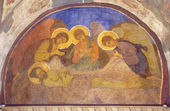
2.1 Mikhail Vrubel, Angels’ Lamentation, 1884. Church of St Cyril, Kyiv. Photograph © Ivan Krutoyarov, all rights reserved.
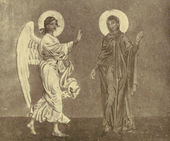
2.2 Mikhail Vrubel, Annunciation, 1884. Watercolour and oil paint, dimensions unknown. Location unknown. Reproduced in Stepan Iaremich, Mikhail Aleksandrovich Vrubel’, zhizn i tvorchestvo (Moscow: Knebel’, 1911), p. 22. Photograph © General Research Division, New York Public Library, Astor, Lenox, and Tilden Foundations, all rights reserved.
However, he found organised religion to be restrictive and oppressive and in the late 1880s began to express a profound doubt about the Christian faith. Instead, he increasingly came to believe that the free pursuit of one’s artistic calling and individual creativity was the most direct route to spiritual attainment and fulfillment, famously stating towards the end of his life: “Art — this is our religion.”8 Although Vrubel had initially pursued the study of law at St Petersburg University, upon graduation he almost immediately enrolled as a full-time student at the Imperial Academy of Arts, where he trained for four years under the direction of Professor Pavel Chistiakov (1832–1919).
In early 1884, while still a student at the Academy, Vrubel was approached by the distinguished art historian and archaeologist, Adrian Prakhov, who at the time was looking for a young artist to help him carry out a large-scale restoration plan in the twelfth-century monastery church of St Cyril. In order to secure the commission, Vrubel was asked to produce a small work in the Byzantine manner. He painted an Annunciation scene (fig. 2.2), which unfortunately has not survived, except for a small black and white photograph that was originally reproduced in Iaremich’s biography.9 Based on the Byzantine iconographic type of the ‘spinning Virgin’, Vrubel’s work demonstrates an intimate familiarity with medieval prototypes, such as the Annunciation mosaics in the eleventh-century St Sophia Church in Kyiv (fig. 2.3) or the twelfth-century Annunciation icon in the Monastery of St Catherine on Mount Sinai (fig. 2.4).10
As a student at the Imperial Academy of Arts, Vrubel would have had access to the Academy’s Museum of Early Russian Art, which housed a vast collection of medieval Byzantine and Russian icons at the time of the artist’s residency.11 These included over one hundred and twenty twelfth-, thirteenth- and fourteenth-century Byzantine icons, as well as several mosaic fragments that Petr Sevastianov had brought over from Mount Athos in 1860.12 In addition, the Academy also possessed a large arsenal of copies and photographs of eleventh- and twelfth-century Byzantine icons, the mosaics of St Sophia in Constantinople, and Manuel Panselinos’ thirteenth-century frescoes in Mount Athos, as well as copies of the icons and frescoes in the twelfth-century Betania and Gelati Monasteries in Georgia.

2.3 The Virgin Mary, 11th century. Mosaic. St Sophia Cathedral, Kyiv. Photograph © Bridgeman Images, all rights reserved.
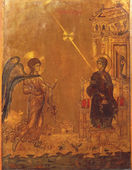
2.4 Annunciation, Late 12th century. Tempera and gold on panel, 63.1 x 42.2 x 3.2 cm. The Holy Monastery of St Catherine, Sinai. Photograph © Bridgeman Images, all rights reserved.
Lastly, the Academy owned a Russian translation of Adolphe Didron and Paul Durand’s famous iconographic manual of Byzantine art, the Manuel d’iconographie chrétienne grecque et latine; traduit du manuscrit byzantin “Le Guide de la Peinture” (Paris, 1845).13 Purportedly compiled in the eighteenth century by Dionysius of Fourna, a monk from Mount Athos, the manual explained techniques of Byzantine painting and described in detail the various iconographies of different religious figures and scenes.14
Although it is now difficult to determine which specific work Vrubel had used as a model for his Annunciation, it is clear that he must have based it on an actual medieval prototype. A comparison between the twelfth-century Sinai Annunciation and Vrubel’s version demonstrates how intuitively the artist had understood the formal and symbolic language of icons without any official training in icon painting. Rather than ‘inhabiting’ the pictorial space of the image, Vrubel’s figures seem to float against an infinite, continuous background that signifies a sacred, symbolic, and timeless realm. Vrubel avoided any directional lighting or shadows in his Annunciation, and his elongation of the figures, the linear dynamism of their draperies, and the serpentine twisting of the angel all closely resemble the Byzantine prototype. Instead of altering the image along naturalistic lines with traditional modelling of the faces and the use of chiaroscuro, as was practised at the time by Academy-trained artists, Vrubel adhered much more closely to the formal language of the medieval icon. It is therefore not surprising that Vrubel’s subsequent first-hand study of monumental medieval art in Kyiv allowed him to internalise the iconic mode of representation still further, and in a way that continued to shape his artwork throughout his career.
Many of Kyiv’s medieval churches and monasteries had suffered considerably over the centuries, falling victim either to the Mongol invasions or to changing artistic tastes, which had resulted in a widespread whitewashing and overpainting of some of the earliest frescoes and mosaics. The St Cyril commission was thus part of a broader restoration project initiated in the 1870s and 1880s to renovate the ancient churches of Kyiv. As part of this commission, Vrubel was tasked with restoring close to one hundred and fifty fragmented figures. In a period of just seven months, with the help of student assistants from the Murashko School, Vrubel repainted large sections of severely damaged murals such as The Annunciation, The Entry into Jerusalem, and The Dormition of the Virgin, and created several wholly new compositions in place of the old ones that had perished. Indeed, the Descent of the Holy Ghost (Pentecost), the Angels’ Lamentation (fig. 2.1), a medallion Head of Christ, Two Angels with Labara (fig. 2.5), and the figure of Moses all seem to have been entirely Vrubel’s own creations.
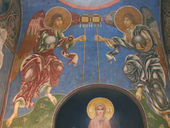
2.5 Mikhail Vrubel, Two Angels with Labara, 1884. Fresco. Church of St Cyril, Kyiv. Detail. Photograph © Ivan Krutoyarov, all rights reserved.
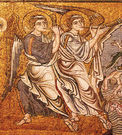
2.6 Angels. Last Judgment. 12th century. Mosaic. Santa Maria Assunta Cathedral, Torcello. Detail. Photograph © Bridgeman Images, all rights reserved.
Vrubel prepared for the commission by studying both the surviving medieval murals in St Cyril and the paintings and mosaics at the monastery of St Mikhail and the Cathedral of St Sophia. He also had access to Prakhov’s large collection of drawings, sketches, photographs, and chromolithographs of medieval Byzantine and Russian art, which the historian had acquired during his travels throughout the Russian empire, Europe, the Middle East, and other formerly Byzantine territories.15 Vrubel would spend many hours in Prakhov’s house studying these images and making copies from them, which he would then incorporate into his designs for the restoration work at St Cyril. For example, Vrubel based his two large frescoes of Two Angels with Labara (1884) (located on the arch of the baptismal chapel) on the angels in the Last Judgment mosaic in the Santa Maria Assunta Cathedral in Torcello (fig. 2.6).16
Although Vrubel’s composition is entirely his own original creation, he adopted many of the formal features of the medieval work, including the agitated fluttering of the draperies, the linear stylisation of the folds, and the dynamic movements and even the facial features of the angels. Similarly, both the iconography and the composition for the Descent of the Holy Ghost mural were inspired by a combination of both original and photographic sources. Vrubel’s semi-circular arrangement of the disciples, as well as his stylised streams of divine light emanating from the Holy Spirit in the form of a dove, all recall the Pentecost mosaic in the Cathedral of Monreale in Italy. However, the fluidity, linearity, and movements of the figures seem more akin to the Pentecost fresco in the Cathedral of St Sophia in Kyiv. Analogous to his first Annunciation painting, these frescoes make manifest how closely Vrubel adhered to the medieval prototypes, imitating their penchant for bright colour, flatness, pronounced outlining, and spatial ambiguity.
Upon completion of the restoration works in St Cyril, Prakhov asked Vrubel to restore four mosaic archangels in the cupola of the Cathedral of St Sophia. One of the angels had retained almost all of its original mosaic tesserae and served as a model for the other three. Vrubel’s task involved the imitation of the mosaic tesserae in oil paint so that from below the restored angels would be impossible to differentiate from the original mosaic compositions.17 This experience was undoubtedly a formative one for the artist, who, upon his return to work in other media, proceeded to adapt this technique as part of his own signature style. For example, in one of his most significant works, Demon Seated (fig. 2.7), which the artist began immediately after his sojourn in Kyiv, the plethora of tiny, block-like, impasto brushstrokes, particularly on the right-hand side of the painting (fig. 2.8), recall mosaic tesserae, and suggest depth and volume, while simultaneously emphasizing the flatness of the picture plane.
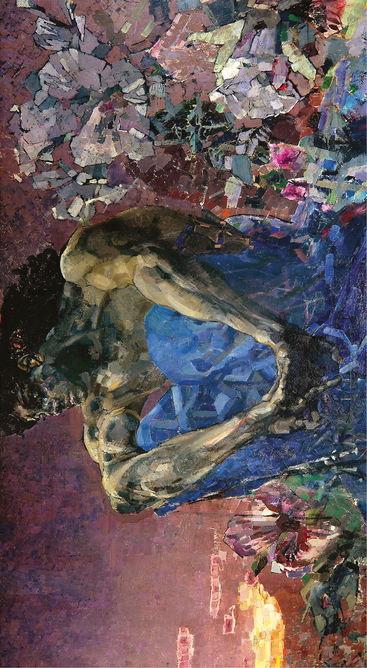
2.7 Mikhail Vrubel, Demon Seated, 1890. Oil on canvas, 116 x 213.8 cm. Tretyakov Gallery, Moscow. Photograph in the public domain. Wikimedia, https://commons.wikimedia.org/wiki/File:Mikhail_Vrubel_-_Демон_(сидящий)_-_Google_Art_Project.jpg
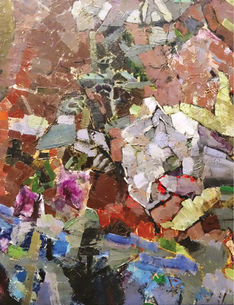
2.8 Mikhail Vrubel, Demon Seated, 1890. Detail. Oil on canvas, 116 x 213.8 cm. Tretyakov Gallery, Moscow. Photograph by Maria Taroutina (2017), public domain.
The monumental figure of Satan is depicted in the immediate foreground of the painting, occupying a compressed, almost claustrophobically shallow space with very little by way of perspectival recession. Although Vrubel included a diminutive mountain and sunset in the distant background, the large geometricised flowers on the right-hand side of the painting emphasise the flatness of the canvas, breaking down the impression of three-dimensional space. The disintegration of their legible forms approaches abstraction so closely that at first glance it is difficult to identify the indistinct angular shapes as flowers. By contrast, Vrubel’s treatment of the Demon’s torso and tensely clasped hands accentuates the heavy solidity of the figure. The Demon’s body registers as a bulky, imposing form, reminiscent of Michelangelo’s nude figures on the ceiling of the Sistine Chapel.
In its masterly combination of pictorial flatness with depth and volumetric solidity, Vrubel’s Demon Seated recalls the paintings of Paul Cézanne, and especially the latter’s Mont Sainte Victoire series (1900–04). Much like Cézanne, Vrubel used flat, overlapping planes to create volume and space out of colouristic contrasts. His crystalline, textured brushstrokes in many ways resemble the colour patches and tectonic facture that Cézanne had developed in his late works. In fact, in his book Of Diverse Arts (1962) the Constructivist artist Naum Gabo went so far as to assert that not only were Vrubel’s radical formal innovations in Demon Seated akin to those of Cézanne, but that the former had, in fact, anticipated the latter by almost fifteen years in his formulation of a vanguard visual syntax.18 In the illustration section of Of Diverse Arts, Gabo strategically juxtaposed one of Cézanne’s Mont Sainte Victoire paintings from 1905 with a study that Vrubel had executed for Demon Seated in 1890–91 in order to demonstrate that the brushwork of the two artists was nearly identical, concluding that:
Vrubel freed the arts of painting and sculpture from the academic and realist schemata. His genius is responsible for moulding the visual consciousness of our generation, which came after him […]. His influence on our visual consciousness was as decisive as Cézanne’s. Even Cubism was not entirely a surprise to us.19
By contrast, the critic Pavel Muratov felt that Vrubel and Cézanne were two very different kinds of artists, both conceptually and stylistically.20 According to Muratov, Cézanne was primarily interested in transcribing the ‘mundane’ realities of everyday provincial life and emphasizing their materiality and solidity. He “painted uncomplicated portraits, landscapes of his homeland and elementary, simple still-lifes”.21 Vrubel, on the other hand, had aspired towards capturing the immaterial, the supernatural, and the divine in pictorial form. His works were meant to be monumental and larger than life, at once reflecting novel ideological concepts and timeless, universal themes.22 According to Muratov, these antithetical artistic goals also expressed themselves on the level of form. Indeed, a closer analysis of Cézanne’s and Vrubel’s brushwork reveals that despite superficial similarities — like the ones outlined by Gabo — there were nonetheless significant structural differences in their respective styles. Unlike Cézanne’s reliance on a systematised grid and passage, which involved the seamless blending of intersecting and perpendicular planes into one another, Vrubel’s brushstrokes tended to vary in size and direction, depending on their structural role in the image (fig. 2.8). As such, they depart from Cézanne’s regularised and geometricised blocks of colour to function more like the individual tesserae in a mosaic composition. A few years after he had completed the St Cyril project, Vrubel explained to Iaremich that his fascination with pictorial flatness and the materiality of the painted surface had evolved out of his encounter with medieval Russo-Byzantine art, which had taught him to achieve “an ornamental distribution of forms in order to strengthen the flatness of the wall”.23 Moreover, as Aline Isdebsky-Pritchard has argued, “the near-impossibility of Vrubel having seen Cézanne’s work […] when this manner became fully developed […] precludes his dependence on the French artist’s work”.24 On his trips to Europe, Vrubel appears to have missed both the first and third Impressionist exhibitions (1874 and 1877) in which Cézanne had participated, and Cézanne’s works did not enter Russian collections until 1904.25 Accordingly, Vrubel seemed to have developed his peculiar modernist syntax simultaneously, but independently, of the French modernist master by incorporating the lessons he had learned from medieval representation into his own work.
Vrubel’s modification of his own painterly style in response to his encounters with medieval art radically departed from the practice of many of his contemporaries and fellow Academicians, such as Viktor Vasnetsov and Mikhail Nesterov, who also worked on church commissions and restoration projects, but who tended to transform the iconic idiom into an academic style, rather than the other way around. Although Vasnetsov and Nesterov adopted the iconography of medieval frescoes and icons, their style principally remained that of naturalistic illusionism. Shedding what they considered to be the ‘primitive’ stylisations of medieval icons and frescoes, these artists saw themselves as modernising and improving the religious simplicity and naiveté of Orthodox imagery. Thus, for example, in Vasnetsov’s painting of the Holy Trinity (1907) for the Alexander Nevsky Cathedral in Warsaw (fig. 2.9), God and Christ are depicted within a three-dimensional space, as evidenced by the naturalistic modelling of the faces, the foreshortening of the figures’ bodies, and the play of light and shadows.

2.9 Viktor Vasnetsov, Holy Trinity, 1907. Preparatory sketch for the Alexander Nevsky Cathedral in Warsaw. Oil on canvas, 268 x 400 cm. State Russian Museum, St Petersburg. Photograph © Fine Art Images/Heritage Images/Scala, all rights reserved.
They are, as it were, emerging out of the heavenly realm into the human world through a ring of intertwined seraphim. Similarly, in his 1892 fresco of the Virgin Mary with Christ Child in the Cathedral of St Vladimir, Nesterov depicted the figures within an illusionistically rendered niche, complete with atmospheric background and perspectival recession. Instead of being depicted frontally, both the Virgin and Christ Child are rotated in space and do not return the viewer’s gaze. Typical of narrative easel painting, their actions are circumscribed within the frame of the painting and do not engage the outside world as in the case of icons.26 Vrubel, on the other hand, understood that iconic visuality was part of a single, holistic aesthetic and ideological system, which could not be altered without violating the very essence of the iconic image.
In the late 1880s and early 1890s the continuing prominence of the Academy, coupled with the new-found popularity of the Association of Travelling Art Exhibitions (Peredvizhniki), ensured that the general public, the Holy Synod, and the official artistic establishment all favoured a more naturalistic representational mode when it came to contemporary church art.27 It is important to emphasise, however, that the Orthodox Church did not indiscriminately accept all realist representations of biblical subjects. For example, Ivan Kramskoi’s Christ in the Wilderness (1872), Polenov’s Christ and the Adulteress (1886), and Nikolai Ge’s What is Truth? (1890) were all viewed as deeply problematic — if not outright blasphemous — from an ecclesiastical standpoint, because they reinterpreted the Christian narrative from historical, archaeological, secular, and subjective perspectives that were often at odds with established theological doctrine.28 By contrast, although Vasnetsov replaced the hieratic qualities of Russo-Byzantine art with mimetic pictorial effects, he nonetheless closely adhered to officially approved Orthodox iconographies and compositions. Moreover, he repeatedly claimed that he was a “sincere Orthodox believer”, who was genuinely committed to ensuring that his religious paintings “did not in any way contradict either the High Christian or the [Orthodox] Church ideal”.29 In other words, his works were ‘new’ and ‘up-to-date’ in form, but ‘traditional’ and ‘timeless’ in content, and could therefore be sacralised as modern iterations in the icon’s long evolution from the Middle Ages to the present moment. One commentator of the period even went so far as to praise Vasnetsov’s ability to “free” medieval iconic representations “from anatomical deformities, which gave the figures their hideous aspect”.30 He continued:
The infantile art of our ancient icon-painters was, of course, powerless in managing this impossible task [of naturalistic representation], due to ignorance and ineptitude. In the drawings of Vasnetsov all of ancient antiquity attained new form and a new hue. And from here — his art connects contemporaneity with the centuries-old history and past of the people, the poetry of its infancy with the perfection of new art.31
Vasnetsov’s paintings simultaneously upheld the authority of the Church and the Academy without deviating too much in the direction of the latter. Paradoxically, however, to the devout ‘simple folk’, who worshipped in the new revivalist churches, Vasnetsov’s images did not register as ‘icons’. Thus, the British writer Rosa Newmarch reported that when a group of “peasants” were asked how they liked the “splendid” new Cathedral of St Vladimir and the “wonderful pictures in it,” they responded that they “like[d] the old icons best” because Vasnetsov’s works had “too much life in them”.32
Vrubel’s religious artworks, on the other hand, were both aesthetically and theologically deviant. They violated the authority of the Academy and that of the Church on the level of style and iconography and were accordingly censured. The St Cyril frescoes were repeatedly criticised for being overly archaizing, and even anachronistic, since they did not reflect the most up-to-date, fashionable realist style, but instead appeared to hark back to an earlier, outmoded representational idiom. Vrubel’s figures were deemed to be anatomically incorrect and poorly executed. They seemed to perversely and deliberately repeat the “hideousness” and “deformation” of the twelfth-century originals. Ironically, it was precisely the effective ‘medievalism’ of Vrubel’s art that affronted nineteenth-century viewers. As the art historian and critic Vsevolod Dmitriev wrote in 1913, the aesthetic re-evaluation of medieval Russo-Byzantine art did not take place until the twentieth century, and only then were Vrubel’s ‘Byzantine’ works fully appreciated by the artistic establishment and the general public alike:
We are witnesses of and participants in a remarkable re-evaluation: ancient Russian icon-painting, till quite recently dead and superfluous for us, today attracts us with ever greater force, as a wellspring of living and immediate beauty. This re-evaluation, which has fundamentally transformed our tastes and our requirements [of art], has also extended to Vrubel […]. The mural paintings at St Cyril’s, the studies for St Vladimir, and the late ‘Byzantine’ works of Vrubel, which used to appear as the prelude and conclusion to the more important Moscow period of the artist’s activity, we now want to put forward as Vrubel’s most fundamental, his most vital aspect.33
However, in the 1880s this was not yet the case. Accordingly, when Prakhov invited Vrubel to submit designs for the interior decoration of the newly built St Vladimir Cathedral, they were promptly rejected by the jury, who deemed them to be too stylistically and iconographically unconventional to be included in the project. Instead, the commission was given to Vasnetsov, Nesterov, the brothers Pavel and Alexander Svedomsky, and the now largely forgotten Polish artist, Wilhelm Kotarbinsky, while Vrubel was invited to execute only a few small decorative ornaments on the interior columns of the cathedral. Retrospectively, it is not hard to see why the conservative jury found Vrubel’s studies to be so problematic. In their compositional simplicity and modernist succinctness, Vrubel’s unprecedented designs stood apart from the mainstream of Russian nineteenth-century church decoration. Unlike the St Cyril frescoes, where Vrubel adhered much more scrupulously to the medieval originals, the St Vladimir sketches betray a focused search for a stylistic and conceptual breakthrough. As in Demon Seated, in these works Vrubel employed medieval means to modernist ends.
Prakhov himself recognised the originality of Vrubel’s proposed fresco cycle, observing that his “superb sketches” required a cathedral in an entirely different and “exceptional style”.34 For instance, in one version of the Lamentation (fig. 2.10), Vrubel depicted the seated Virgin against a low horizon, towering above the flat, horizontal body of Christ, which is virtually reduced to a single white line.

2.10 Mikhail Vrubel, Lamentation I, 1887. Sketch for a mural in the St Vladimir Cathedral, Kyiv. Pencil, watercolour, and whitewash on paper, 43.4 x 59.2 cm. State Museum of Russian Art, Kyiv. Photograph © Fine Art Images/Heritage Images/Scala, all rights reserved.
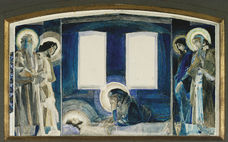
2.11 Mikhail Vrubel, Lamentation II, 1887. Detail. Sketch for a mural in the St Vladimir Cathedral, Kyiv. Pencil, watercolour, and whitewash on paper, 43.4 x 59.2 cm. State Museum of Russian Art, Kyiv. Photograph © Fine Art Images/Heritage Images/Scala, all rights reserved.
A diminutive cross is visible against the setting sun in the distant background, referencing the Crucifixion. Two cypress trees on the right-hand side of the image rhythmically repeat the vertical silhouette of the Virgin’s body. The resolutely perpendicular placement of the Virgin in relation to the horizontal Christ echoes the configuration of the cross, signalling the underlying spiritual geometry of the composition. Although Vrubel did not portray Christ and the Virgin with traditional haloes, the setting sun on the horizon, strategically rendered just above Christ’s head, metaphorically doubles as a luminous nimbus. Thus, instead of employing standard Orthodox iconography, Vrubel relied on purely compositional devices to signal the sacred nature of the depicted scene. Similarly, rather than emphatic gesturing and outward signs of emotion, typical of lamentation scenes, Vrubel depicted the Virgin with a stoic facial expression in a moment of quiet meditation, exemplifying a particularly ‘modern’ sensibility of interiority and controlled grief. The solid, vertical, upward thrust of the Virgin’s body is striking in its reticent minimalism, while the entire scene is rendered with just a few, unmodulated strokes of colour within a flattened, shallow space.
In another variant of the Lamentation (fig. 2.11), Christ and the Virgin are situated indoors with two windows just above the Virgin’s head dominating the entire design. Rather than occupying the centre of the image, Christ and the Virgin are again relegated to the bottom edge of the composition. In his treatment of the Virgin’s garments and face, Vrubel began to explore the mosaic-like fragmentation of form into distinct colour patches, which he would develop more fully in his subsequent paintings Demon Seated and the Portrait of Savva Mamontov. The two windows, rendered as flat, white geometric planes against a monochromatic, dark background, have an almost proto-Suprematist quality. Composed of passages of negative space — brilliant white blank paper — they become the visual focal point of the composition. Their role as ‘windows’ suggests an opening into another spatial register, inviting the viewer to look through them, but simultaneously frustrating this desire with their flat opacity. Since Vrubel did not submit this particular work to the jury for the St Vladimir commission, these blank windows cannot simply be understood as architectural features in the cathedral, around which Vrubel structured his design. Instead, they seem to serve a purely pictorial and metaphorical function in the image. In their striking, white luminosity, they were perhaps intended to function symbolically as gateways into the holy realm, to which human beings do not have direct access except through the mediation of Christ and the Virgin, who are accordingly depicted in the immediate foreground of the image and closest to the viewer. Akin to the gold background of icons, these windows serve as a material reminder of the separation between this world and the one that lies beyond. In his choice of stark, rectangular forms, Vrubel may have even been drawing on the holy geometries of Orthodox iconography, where Christ was often depicted enthroned against a background of three large geometrical shapes: a red diamond, a blue-black oval, and a red rectangle. The same visual effect was repeated by Vrubel in his design for the Resurrection (fig. 2.12), in which Christ is shown emerging out of a grave, framed by a stylised mandorla of simplified geometric shapes.
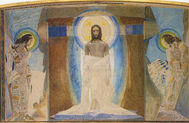
2.12 Mikhail Vrubel, Resurrection, 1887. Central panel of a triptych; side panels depict figures of angels. Sketch for a mural in the St Vladimir Cathedral, Kyiv. Photograph © Bridgeman Images, all rights reserved.
Lastly, the visual impenetrability of the windows in the Lamentation scene may also suggest the essential unknowability of the realm beyond, signalling Vrubel’s own existential doubts and long-term interest in the writings of Friedrich Nietzsche.35 Unlike Vasnetsov’s fanciful starry night sky in the Holy Trinity, Vrubel’s designs gesture towards a Nietzschean — and by extension, a quintessentially modern — attitude towards faith and religion, marked by doubt, ambiguity, self-questioning, and introspection. Needless to say, this stance was antithetical to official Church doctrine, which demanded that iconic representations affirm rather than question the metaphysical realities they depict. However, by the opening decade of the twentieth century, a new generation of artists and Symbolist poets and writers began publicly to endorse the extraordinary originality and compositional inventiveness of Vrubel’s St Vladimir sketches, signalling a change of direction in Russian aesthetic tastes and spiritual sensibilities. To these younger viewers, Vrubel’s searching, dialectical, ‘free’ approach to religious representation appeared to be more sincere, substantive, and resonant with modern reality. In addition, it struck them as being paradoxically closer to the spiritual ethos of the medieval prototypes, in contrast to what was perceived as Vasnetsov’s and Nesterov’s passive, mechanical imitation of ossified Orthodox dogma. Thus, writing in 1900, Alexandre Benois expressed his profound disappointment with the works of Vasnetsov and Nesterov in the St Vladimir Cathedral:
[At the time of their creation] the St Vladimir frescoes aroused considerable pride among the Russian public as only the contemporaries of Raphael and Michelangelo might have been proud of these masters’ creations in the Vatican […]. However, once I encountered the St Vladimir murals in situ, I abandoned all of my previous illusions. I was deeply saddened […] the problem was that [Vasnetsov] took more upon himself than he could manage! […] The falsehood inherent in the St Vladimir murals signified not the personal deception on the part of the artist, but rather the deception, deadly and terrible, of our entire spiritual culture.
I was even more disappointed with the frescoes of my ‘friend’ Nesterov. His altarpiece of the Nativity betrayed both flagrantly bad taste and a sweet-and-flabby sensibility, which the artist tried to masquerade as something delicate and fragrant […]. However, after having seen this Nativity, I fully understood that Nesterov was irretrievably lost to genuine art.36
Only Vrubel received unconditional praise from Benois:
I went […] to the St Cyril Church, specifically for the purpose of acquainting myself with Vrubel’s works. I dedicated almost three hours to the close scrutiny of his frescoes and even if I did not leave the church with some kind of sense of indefinable joy, I was nonetheless amazed by the sheer technical mastery with which the very unusual ‘local images’ of the iconostasis were painted […] and by what I would call the ‘inspired intelligence’ with which [Vrubel] restored the Old Byzantine frescoes […] and created the entirely new ones […]. Everywhere a deep reverence towards antiquity is harmoniously combined with the creative outbursts of a free imagination.37
If Vrubel, instead of Vasnetsov, would have been able to execute on a monumental scale his ideas [for the Cathedral of St Vladimir] […] then probably […] we would have been the only place in the world in contemporary times, where on the walls of God’s cathedral there would have appeared a truly living and truly inspired logos.38
Writing over two decades after Benois, the leftist art critic Nikolai Tarabukin went further, claiming that Vrubel was single-handedly responsible for bringing about an aesthetic re-evaluation of the iconic representational idiom in the twentieth century:
At the time that Vrubel began his works [in Kyiv], there were no archaeological discoveries of […] and scholarship on ancient [Russo-Byzantine] mural painting, which are accessible to us today. The turning point in attitudes towards the ancient past of Russian art occurred after Vrubel. In his oeuvre, Vrubel himself turned out to be a pioneer of Russo-Byzantine art, as a result of which the art of the past appeared to the gaze of the contemporary world in a totally different light.39
Tarabukin’s assertion was, of course, inaccurate, given that scholars such as Nikodim Kondakov and Prakhov had already begun to publish their research on medieval Byzantine and Russian art and architecture as early as the 1870s and 1880s. However, as already mentioned, at that moment public taste was still largely rooted in a naturalistic tradition of painting, and it was not until the twentieth century that icons began to enjoy a much broader aesthetic appreciation. Consequently, just as Dmitriev had suggested a decade earlier, Tarabukin had not been entirely wrong in claiming that Vrubel’s artistic consciousness and worldview already belonged to the twentieth rather than the nineteenth century.
Vrubel’s exposure to medieval mosaics and frescoes in Kyiv not only influenced his oeuvre stylistically, but also made a lasting thematic impact on his art, prompting the artist to turn to uncanny subject matter and to explorations of the darker aspects of human psychology. In fact, in the course of the restoration works, Vrubel spent much of his time studying and sketching the mentally ill patients of a small psychiatric clinic that had been set up in some of the disused buildings of the former monastery, not far from the church. He found that the patients’ physical expression of inner turmoil formed a useful parallel to the scenes of religious ecstasy that he was depicting in the St Cyril frescoes.40 By contrast, during his student years at the Academy Vrubel had predominantly depicted literary, historical, and classical subject matter. It was only after his time in Kyiv that the artist devoted himself almost exclusively to supernatural themes. Even long after the completion of the St Cyril project, Vrubel continued to depict biblical and religious subjects, developing his own particular brand of Symbolism filled with supernatural and mythological beings, fairies, woodland creatures, angels, and demons. In this way, his encounter with the medieval Russo-Byzantine artistic tradition not only contributed to the evolution of his painterly style, but also to his conceptual and theoretical approach to art. In fact, after the rejection of his sketches from the St Vladimir project, Vrubel seemed to transfer his frustrated aspirations for monumental religious painting into his Demon series. In a telling letter to Vrubel’s sister, the artist’s father explained that Vrubel conceptualised the Demon not so much as an “evil spirit”, but one “that is suffering and insulted, but nevertheless a spirit that is powerful […] [and] noble” — a characterisation of the Demon that Vrubel’s subsequent biographers and critics would come to read as an avatar for the artist himself.41
Vrubel produced his first Demon sketches in 1885 while he was still in the process of restoring the Church of St Cyril. In his monograph on Vrubel, Tarabukin argued that there was a direct correlation between the Demon series and the St Cyril frescoes, even on the level of iconography. According to Tarabukin, the physiognomy of the St Cyril Virgin gradually evolved into that of the Demon, and he claimed that the latter became the antithesis of the former.42 Indeed, a comparison between Vrubel’s sketches of the Virgin’s head and that of the Demon (figs. 2.13 and 2.14) reveals shared facial features such as the downward slant of the round, large, expressive eyes, the long, uneven ridge of the nose, the full plump lips, and even the tilt of the head.
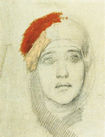
2.13 Mikhail Vrubel, Study for the Virgin, 1884. Pencil and gouache on paper, 43 x 32.3 cm. Tretyakov Gallery, Moscow. Photograph © Bridgeman Images, all rights reserved.
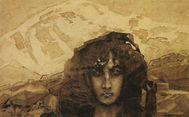
2.14 Mikhail Vrubel, Head of Demon, 1890. Watercolour on cardboard, 23 x 36 cm. State Museum of Russian Art, Kyiv. Photograph © Bridgeman Images, all rights reserved.
The Virgin’s face was thus transformed into a slightly hardened and more virile visage of the Demon. By contrast, Iaremich thought that the facial features of Vrubel’s Moses, rather than the Virgin, were directly translated into the early Demon works.43 In either case, there seemed to be an explicit link between the iconographic types that Vrubel had developed for the St Cyril commission and that of the Demon. In the years 1887 to 1900 a distinct stylistic and thematic evolution occurred in Vrubel’s work, wherein the figure of the Demon became an amalgamation of all of the artist’s previous experiences with religious art and public monumental painting. The lines of demarcation between the angelic, the demonic, and the Christological thus became increasingly blurred in these years to the point of being wholly interchangeable.
For example, the iconographic and physiognomic type of the Angel (fig. 2.15), which Vrubel had initially developed for the St Vladimir project in 1887, was gradually transformed by the artist into the prototype for the Demon. In fact, subsequent scholars have variously labelled Vrubel’s Study of a Head (fig. 2.16) as either the Head of an Angel, dated 1887, or alternatively the Head of the Demon, dated 1890.44 Similarly, the same pencil drawing from 1904 has also been variously titled The Demon or The Seraph in different publications, indicating the slippage in fixed iconographic meaning.45 Of course, given the fact that the Demon was himself an angel at one point, this iconographic continuity was certainly appropriate to the subject matter and the duality that was already implicit in the nature of the ‘fallen’ angel. It is therefore not surprising that the subjects overlap in Vrubel’s oeuvre from the start of his artistic career until the end, becoming more prominent in his late paintings. For example, the largest of Vrubel’s late paintings, The Six-Winged Seraphim of 1904, is closely related to his 1902 magnum opus, Demon Cast Down (fig. 2.17) both in facial type and the emphasis on the beautiful, coloured wings which envelop both figures.

2.15 Mikhail Vrubel, Angel with a Candle, 1887. Watercolour, pencil, and varnish on paper, 69 x 26 cm. State Museum of Russian Art, Kyiv. Photograph © Bridgeman Images, all rights reserved.
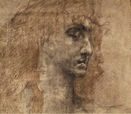
2.16 Mikhail Vrubel, Head of an Angel, 1887 or Head of the Demon, 1890. Charcoal and red crayon on paper, 41 x 68 cm. Tretyakov Gallery, Moscow. Photograph © Bridgeman Images, all rights reserved.
However, Demon Cast Down also alludes to Christ’s suffering and sacrifice by showing the demon wearing what looks like a crown of thorns on his head, a traditional symbol of Christ’s Passion. Moreover, according to the reports of his friends, Vrubel was planning to exhibit his Demon Cast Down in Paris under the title Icône, clearly aligning this work with the spiritual and aesthetic realm of religious art.46 Even on the level of form, Vrubel wanted Demon Cast Down to resemble an icon, and he had meticulously applied a metallic bronze powder to the demon’s wings, which would catch the light, producing a glowing, reflective effect typical of an icon. The painter Konstantin Bogaevsky recalled that when he saw the painting on the first day of its display at the World of Art exhibition in 1902:
It produced a strong impression on me, which I can compare to no other. It glowed as if it were made of precious gems, so that everything around it seemed grey and unsubstantial […]. Vrubel’s ‘Demon’ has darkened severely, the colours which once shone on the canvas have paled; the bronze powder which was used for the peacock feathers has become green […].47
References to Christ have also been read into Vrubel’s Demon Seated, whose intense self-reflection, clasped hands, and poignant isolation in an empty landscape have often been compared to Ivan Kramskoi’s painting Christ in the Wilderness (1872), which shows an emaciated and haggard-looking Christ, deep in thought and contemplating His onerous fate in a rocky, desert setting.48 In his later years, Vrubel claimed to greatly admire this work, as well as Nikolai Ge’s Christ in the Garden of Gethsemane (1888) because of the latter’s ‘demonic’ qualities.49 Vrubel’s unconventional merging of the conceptual and formal boundaries between Christ and Satan, the angelic and the demonic, the profane and the iconic, and damnation and redemption reflects a particularly modern, fin-de-siècle mentality, characterised by a feeling of alienation from the Christian experience and a sense of the disintegration of previously fixed and stable identities and institutions, including those of conventional morality and the religious establishment.
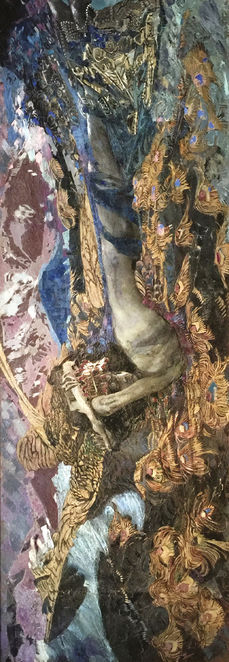
2.17 Mikhail Vrubel, Demon Cast Down, 1902. Oil on canvas, 139 x 387 cm. Tretyakov Gallery, Moscow. Photograph in the public domain. Wikimedia, https://commons.wikimedia.org/wiki/File:Vrubel_Fallen_Demon.jpg
In addition, it was precisely in the years that Vrubel first began to work on his Demon in the mid-1880s that he also produced a series of paintings illustrating Christ’s Passion, which he subsequently destroyed leaving only a charcoal sketch of Christ in the Garden of Gethsemane (1888). It was at this moment that Vrubel first experienced something of a personal religious crisis. Writing to his sister Anna in December 1887, he complained that while he was working on his paintings of Christ “with all his might” he began to feel a profound sense of malaise towards his Christian identity, an emotion that continued to plague him until the end of his life and especially during his illness.50 Given Vrubel’s interest in the writings of Nietzsche, it would seem that in his conception of Christ, the demon, and the figure of the prophet, Vrubel envisioned a heroic individual — even a martyr — whose rebellion against the conventional morality and dominant trends of his times seemed to mirror Vrubel’s own artistic struggles. From his university years, the artist had rejected mainstream religiosity and especially its formulation in the works and theories of Leo Tolstoy, which Vrubel claimed resulted in the oppression of the human spirit and the creative impulse. Whether or not Vrubel saw himself in prophetic terms as an avant-garde martyr to conservative artistic tastes is unclear, but he was certainly understood as such by many of his contemporaries, such as Aleksandr Blok, Benois, and Muratov. Both of Blok’s articles, ‘To the Memory of Vrubel’ and ‘On the Present State of Russian Symbolism’, imply the fusion of self-sacrifice and prophetic vision as the condition for Vrubel’s art; the same idea is expressed by Muratov in his essay, ‘About High Art’.51 Similarly, in his 1910 article on Vrubel for the journal Speech (Rech’), Benois concluded that “Vrubel was more than just an artist — he was a prophet, a seer, a demon”.52
Vrubel’s dedication to the prophetic, the visionary, and the iconic reached its apogee in the years leading up to his premature death in 1910, and almost all of his major late works exclusively deal with Biblical subjects and the supernatural. In the years 1904 to 1905 he painted The Six-winged Seraphim (1904), Angel with a Sword (1904), the Head of the Prophet (1904–05), the Prophet (1904–05), Head of John the Baptist (1905), and The Vision of the Prophet Ezekiel (1906), among others. In many ways, this final cycle of religious works can be interpreted as a symbolic summation or culmination of the central stylistic and thematic preoccupations that characterised Vrubel’s entire career. For example, in its iconic frontality, pronounced linearity, and vivid palette, the watercolour of the Head of John the Baptist (fig. 2.18) again recalls the artist’s St Cyril murals, such as his fresco of Moses and the Head of Christ.
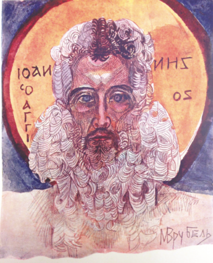
2.18 Mikhail Vrubel, Head of John the Baptist, 1905. Watercolour and pencil on paper, 21.3 x 17.6 cm. State Russian Museum, St Petersburg. Reproduced in Zolotoe runo, 1906, 1, Colour inset. Photograph by Maria Taroutina (2017), public domain.
Similarly, The Six-winged Seraphim, also known as Azrael or the Angel of Death (fig. 2.19), harks back to Vrubel’s Demon paintings in its striking grandeur, monumentality, and ambiguous duality. In terms of iconography, The Six-winged Seraphim closely resembles the Demon Seated with his long black hair, powerful neck, blue-grey complexion, hollow eyes, and large peacock wings. Just like Vrubel’s Demon, Azrael is an ambiguous, conflicted figure. Crowned with a lustrous diadem and holding a glowing red censer in his left hand, the angel is the source of heavenly light and salvation on the one hand. However, on the other hand, he is simultaneously the harbinger of death, wielding a large, ominous dagger in his right hand, and signifying suffering and destructive intent. Just like the Demon, who was once an angel, Azrael appears as a liminal figure who stands on the threshold of heaven and hell, embodying both the angelic and the demonic, or redemption and damnation. On a formal level, The Six-winged Seraphim combines many of the techniques that Vrubel first used in Demon Seated and Demon Cast Down. Vrubel’s modelling of form on the angel’s face and neck repeats the interlocking, contrasting colour patches that he used to build up the bulky body of Demon Seated. In their regularity and geometricity, these blocks of paint resemble mosaic tesserae even more than in Demon Seated and appear to have been applied with a palette knife, rather than a paintbrush (fig. 2.20).
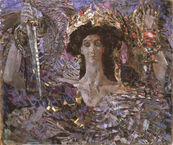
2.19 Mikhail Vrubel, The Six-winged Seraphim (Azrael), 1904. Oil on canvas, 131 x 155 cm. State Russian Museum, St Petersburg. Photograph © Fine Art Images/Heritage Images/Scala, all rights reserved.
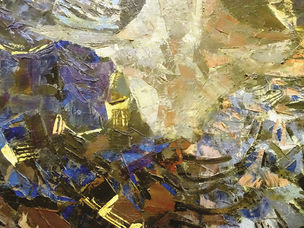
2.20 Mikhail Vrubel, The Six-winged Seraphim (Azrael), 1904. Detail. Oil on canvas, 131 x 155 cm. State Russian Museum, St Petersburg. Photograph by Maria Taroutina (2017), public domain.
Meanwhile, the expressive swirl of crystalline brushstrokes on the angel’s wings and garments recalls the fragmented, chaotic mass of peacock feathers in Demon Cast Down. Measuring 131 by 155 cm., this work is one of the largest of Vrubel’s late paintings — his penultimate, poignant attempt at monumental religious art.
The Vision of the Prophet Ezekiel (fig. 2.21) is considered to be Vrubel’s last work and approaches near abstraction in its radical dissolution of form. Executed on cardboard in mixed media — charcoal, watercolour, and gouache — it depicts a heavenly vision as described in the Old Testament Book of Ezekiel. In the bottom right-hand corner of the image, the face of a bearded man — presumably Ezekiel — is depicted looking up at a tall, fearsome angel who holds a downward pointing sword in his right hand. Next to the angel is another floating masculine face, but one that lacks a clearly identifiable body. The pronounced spatial ambiguity of this work is produced by a multiplicity of layered, shifting fragments of form that splinter into infinite depths and yet insist on returning to the surface of the picture plane. An explosion of angular, faceted shapes destabilises the figure-to-ground relationship so that it becomes difficult to tell where one form projects forward and another recedes into the background, producing a dynamic all-over effect. The only stable visual anchor in the whole composition is the angel’s dark head in the central, upper register of the image. Otherwise, the intermingling of segments of wings, limbs, and dissolving faces creates a complicated, disorienting web of form that approaches abstraction more closely than in any other of Vrubel’s late works.

2.21 Mikhail Vrubel, The Vision of the Prophet Ekeziel, 1905. Charcoal, watercolour, and gouache on cardboard. 102.3 x 55.1 cm. State Russian Museum, St Petersburg. Photograph © Fine Art Images/Heritage Images/Scala, all rights reserved.
In fact, it is as though Vrubel’s initial experimentation with the ‘abstract’ qualities of Russo-Byzantine art in the Church of St Cyril had come full circle and had reached its most logical conclusion both in terms of style and subject matter, heralding a new era in Russian art. Adrian Prakhov’s son, Nikolai, went so far as to read the beginnings of Rayonism — an early abstract art movement inaugurated by Mikhail Larionov in around 1913 — in the fragmented, energetic, linear shards of The Vision of the Prophet Ezekiel. Indeed, Larionov himself claimed that Vrubel exerted more influence on him than Cézanne.53 As a number of scholars have written, many members of the younger generation of artists passed through Kyiv in the early 1900s and were deeply affected by their encounters with Vrubel’s St Cyril frescoes. Liubov Popova’s visit to the church in 1909 left her “vanquished” by Vrubel’s “incinerating” talent.54 Similarly, Aleksandr Rodchenko asserted that in the early 1910s he “painted like Vrubel”, while Vladimir Tatlin prized and avidly collected Vrubel’s artwork.55 Other budding avant-garde talents who had encountered Vrubel’s work in Kyiv in the early 1900s include Natalia Goncharova, Aleksandra Ekster, Aleksandr Archipenko, David Burliuk, and Kazimir Malevich, among others.
Yet, whether or not Vrubel’s religious works contributed to the advent of abstraction in Russia in the new century is almost impossible to ascertain with any certainty. However, what is clear is that Vrubel’s radical rewriting of the Russo-Byzantine artistic idiom, as well as his combination of formal innovation with visionary transcendentalism, paved the way for artists such as Malevich and Kandinsky, for whom spirituality and abstraction came to represent two sides of the same modernist coin. Dmitriev summed it up best, describing Vrubel as:
Аn artist who managed to raise above the heads of his contemporaries the future ‘necessity’ of art […] already perceived his significance before and more astutely than anyone else. […] Vrubel, in the last years of his life, had already arrived at a conception of art, which we are only now beginning to approach. Consequently, our reappraisal is not the result of the fashion of the day. We are merely trying to follow the path that Vrubel had indicated to us.56
As paradoxical as it may sound, by embracing the artistic traditions of the past, Mikhail Vrubel was able to anticipate many of the formal and conceptual innovations of the future. Moreover, in their brooding, unorthodox nature, his apocryphal paintings epitomised the modern move away from institutionalised religion towards new spiritual and philosophical possibilities that would be subsequently embraced by a younger generation of writers and thinkers such as Blok, Mikhail Kuzmin, Dmitry Merezhkovsky, Zinaida Gippius, and Mikhail Bulgakov. Thus, speaking at Vrubel’s funeral in 1910, Blok poetically asserted that in his art and life Vrubel had followed “the sounds of heaven” instead of the “boring songs of earth” — sounds that had inspired the artist to produce his iconic Demon — a “symbol of the age”.57
1 Mikhail Vrubel, quoted in Stepan Iaremich, Mikhail Aleksandrovich Vrubel’; zhizn’ i tvorchestvo (Moscow: Knebel’, 1911), p. 55. “Вот к чему в сущности я должен бы вернуться.”
2 From 1887 to 1889, Vrubel had produced a large number of sketches for the interior decoration of the St Vladimir Cathedral in Kyiv. Unfortunately, the jury that oversaw this project rejected almost all of Vrubel’s designs.
3 Nikolai Punin, ‘K risunkam M. A. Vrubelia’, Apollon, 5 (May 1913), 5–15 (p. 7), http://www.v-ivanov.it/issledovaniya_i_materialy/apollon. “В этих работах художник коснулся такой силой духа и прозрения известных проблем живописи, что те немногии страницы которые повествуют о киевском периоде творчества Врубеля, должны, на наш взгляд, возрасти в громадную литературу, всецело посвященную смыслу и значению именно этих композиций.”
4 See: Aline Isdebsky-Pritchard, The Art of Mikhail Vrubel (1856–1910) (Ann Arbor, MI: UMI Research Press, 1982); Nina Dmitrieva, Mikhail Aleksandrovich Vrubel′ (Leningrad: Khudozhnik RSFSR, 1984), pp. 32–56 and 67–90; Mikhail Alpatov, Zhivopisnoe masterstvo Vrubelia (Moscow: Lira, 2000), pp. 87–112; Viktoria Gusakova, Viktor Vasnetsov i religiozno-natsional′noe napravlenie v russkoi zhivopisi kontsa XIX–nachala XX veka (St Petersburg: Aurora, 2008), pp. 121–49.
5 For example, see Dmitrieva’s discussion of Vrubel’s late religious works in Mikhail Aleksandrovich Vrubel’, pp. 82–84.
6 In the first two decades of the twentieth century a large number of Russian artists turned to the iconic tradition as a source of pictorial and conceptual inspiration. Avant-garde engagement with iconic representations ranged from a primitivising adaptation of iconic forms to thematic and iconographic borrowings. For a detailed account of the widespread influence of icons on early twentieth-century Russian art, see: Andrew Spira, The Avant-Garde Icon: Russian Avant-Garde Art and the Icon Painting Tradition (Aldershot, Hampshire; Burlington, VT: Lund Humphries, 2008); Alter Icons: The Russian Icon and Modernity, ed. by Jefferson J. A. Gatrall and Douglas Greenfield (University Park, PA: Pennsylvania State University Press, 2010); Jane A. Sharp, Russian Modernism Between East and West: Natal′ia Goncharova and the Moscow Avant-Garde (Cambridge: Cambridge University Press, 2006), pp. 143–95, 221–53; Margaret Betz, ‘The Icon and Russian Modernism’, Artforum 15, 10 (Summer 1977), 38–45; John Bowlt, ‘Neo-Primitivism and Russian Painting’, The Burlington Magazine, 116, 852 (March 1974), 133–40; Robin Milner-Gulland, ‘Icons and the Russian Modern Movement’, in Icons 88, ed. by Sarah Smyth and Stanford Kingston (Dublin: Veritas Publications, 1988), pp. 85–96.
7 In a letter to his sister Anna, Vrubel mentions attending Catholic mass with his father. Letter from Mikhail Vrubel to Anna Vrubel, October, 1872. Reprinted in E. P. Gomberg-Verzhbinskaia, Vrubel’: Perepiska, vospominaniia o khudozhnike (Leningrad: Iskusstvo, 1976), p. 23.
8 Anna Vrubel, ‘Reminiscences about the Artist’, in Gomberg-Verzhbinskaia, Vrubel’, p. 154. “Искусство — вот наша религия.”
9 Iaremich, Vrubel’, p. 22.
10 The well-known Byzantinist, Nikodim Kondakov, published a photographic album in 1881 containing one hundred images of mosaics and miniatures from illuminated manuscripts in the collections of the St Catherine Monastery on Mount Sinai. See N. P. Kondakov, Vues et antiquités du Sinai par M. le professeur Kondakoff et photographe J. Raoult (Odessa: [s.n.], 1881). However, it remains unclear whether Vrubel would have had access to it. For a more detailed discussion of Kondakov’s career and publications, see Chapter 8 of this volume.
11 For a history of the Academy’s museum and its collection, see Iu. A. Piatnitskii, ‘Muzei drevnerusskogo iskusstva Akademii khudozhestv’, in Vizantinovedenie v Ermitazhe, ed. by V. S. Shandrovskaia (Leningrad: State Hermitage Museum, 1991), pp. 14–19.
12 For a detailed account of Sevastianov’s expeditions to Mount Athos and his collection of Byzantine art, see Iu. A. Piatnitskii, ‘P. I. Sevastianov i ego sobranie’, in ibid., pp. 19–24.
13 Adolphe Didron and Paul Durand, Manuel d’iconographie chrétienne grecque et latine; traduit du manuscrit byzantin “Le Guide de la Peinture” (Paris: Imprimerie Royale, 1845). See Anna Kornilova, ‘Iz istorii Ikonopisnogo klassa Akademii Khudozhestv’, in Problemy razvitiia zarubezhnogo i russkogo iskusstva: sbornik nauchnykh trudov, ed. by Vera Razdol’skaia (St Petersburg: Institut Imeni I. E. Repina, 1995), pp. 73–77 (p. 76).
14 Dionisii Furnoagrafiot, Erminiia ili Nastavlenie v zhivopisnom iskusstve, sostavlennoe iermonakhom i zhivopistsem Dionisiem Furnoagrafiotom, 1701–1733 god (Kyiv: Tip. Kievopecherskoi Lavry, 1868). For a recent edition in English, see Paul Hetherington, ed., The ‘Painter’s Manual’ of Dionysius of Fourna: An English Translation [from the Greek] with Commentary of Cod. Gr. 708 in the Saltykov-Shchedrin State Public Library, Leningrad (London: Sagittarius Press, 1974).
15 Gusakova, Vasnetsov, p. 123.
16 There is some disagreement over the original source for these angels. Iaremich claims that Vrubel based the composition on photographs of the Torcello mosaics in Adrian Prakhov’s collection. However, Nikolai Prakhov recounts that Vrubel produced the design after he had returned from his to trip to Italy, where he had seen the Torcello mosaics in situ. See Iaremich, Vrubel’, p. 54, and Nikolai Prakhov, Stranitsy proshlogo: Ocherki-vospominaniia о khudozhnikakh (Kyiv: Obrazotvorchogo-Mistetsva i Muzichnoi Literatury U.S.S.R., 1958), p. 284.
17 Letter from Mikhail Vrubel to Adrian Prakhov, Summer 1884. Reprinted in Gomberg-Verzhbinskaia, Vrubel’, p. 71.
18 Naum Gabo, Of Diverse Arts (New York: Pantheon Books, 1962), pp. 168–69.
19 Ibid., pp. 155–56.
20 Pavel Muratov, ‘Vrubel′’, Moskovskii ezhenedel′nik, 15 (10 April 1910), 45–50.
21 Ibid., p. 48.
22 Ibid.
23 Iaremich, Vrubel’, p. 52. “[…] при помощи орнаментального раположения форм усилить плоскость стены.”
24 Isdebsky-Pritchard, Art of Mikhail Vrubel, p. 86.
25 Ibid., p. 257 (note 51). For Russian collections of Modern French art, see: Beverly Whitney Kean, French Painters, Russian Collectors: The Merchant Patrons of Modern Art in Pre-Revolutionary Russia (London: Hodder & Stoughton, 1996); Albert Kostenevich, Impressionist Masterpieces and Other Important French Paintings Preserved by the State Hermitage Museum (St Petersburg: Harry N. Abrams, 1995); Morozov, Shchukin: the Collectors: Monet to Picasso: 120 Masterpieces from the Hermitage, St Petersburg, and the Pushkin Museum, Moscow (exh. cat., Bonn: Bild-Kunst, 1993).
26 For a detailed discussion of the cultural and conceptual role of the picture frame and its ever-changing functions in Russian art see Oleg Tarasov, Framing Russian Art: From Early Icons to Malevich, trans. by Robin Milner-Gulland and Antony Wood (London: Reaktion Books, 2011); for more on the frame in relation to the icon see Tarasov’s chapter in this volume (Chapter 5, especially p. 116).
27 For a detailed discussion of this subject, see Sharp, Russian Modernism, pp. 238–53.
28 For a good overview of this topic, see Jefferson J. A. Gatrall, The Real and the Sacred: Picturing Jesus in Nineteenth-Century Fiction (Ann Arbor, MI: University of Michigan Press, 2014), pp. 62–89.
29 Letter from Viktor Vasnetsov to Adrian Prakhov, Spring 1885. Reprinted in Viktor Vasnetsov: pis′ma, novye materialy, ed. by Liudmila Korotkina (St Petersburg: Izdatel’stvo ‘ARS’, 2004), p. 58.
30 V. Svechnikov, ‘Tvorchestvo V. M. Vasnetsova i ego znachenie dlia russkoi religioznoi zhivopisi’, Svetil′nik: religioznoe iskusstvo v proshlom i nastoiashchem, 67 (Moscow, 1913), 3–19 (p. 5).
31 Ibid.
32 Rosa Newmarch, The Russian Arts (New York, NY: E. P. Dutton and Company, 1916), p. 224.
33 Vsevolod Dmitriev, ‘Zavety Vrubelia’, Apollon, 5 (May 1913), 15–18 (p. 15), http://www.v-ivanov.it/issledovaniya_i_materialy/apollon. “Мы — зрители и участники знаменательной переоценки: древнерусская иконопись, еще недавно бывшая для нас мертвой и ненужной, ныне все с большей и большей силой притягивает нас, как родник красоты живой и близкой. Эта переоценка, существенно изменившая наш вкус и требования, коснулась и Врубеля […]. Pосписи Кирилловской церкви, эскизы для Владимирского собора последние «византийские» работы Врубеля, прежде понимаемые только как вступление и заключение к главному московскому периоду творчества художника, нам хочется выдвинуть вперед как основное, как самое жизненное во Врубеле.”
34 N. A. Prakhov, ‘Mikhail Aleksandrovich Vrubel′’, reprinted in Gomberg-Verzhbinskaia, Vrubel’, p. 187. “Превосходные эскизы показал мне сегодня в соборе Михаил Александрович, но для них надо построить собор совершенно в особенном стиле.”
35 For an in-depth study of Vrubel’s sustained interest in Nietzsche, see Aline Isdebsky-Pritchard, ‘Art for Philosophy’s Sake: Vrubel Against “the Herd”’, in Nietzsche in Russia, ed. by Bernice Glatzer Rosenthal (Princeton, NJ: Princeton University Press, 1986), pp. 219–48.
36 Alexandre Benois, Moi vospominaniia, Vols. IV, V (Moscow: Nauka, 1980), p. 275. “Владимирским собором русские люди той эпохи гордились так, как разве только современники Рафаэля и Микеланджело могли гордиться фресками обоих мастеров в Ватикане […]. Однако, увидав роспись Владимирского собора на месте, я простился с какими-либо иллюзиями. Я был глубоко огорчен […] беда была в том, что [Васнецов] взялся за задачу, которая была ему не по плечу! […] Фальшь, присущая ‘стенописи’ Владимирского собора, не личная ложь художника, а ложь, убийственная и кошмарная, всей нашей духовной культуры. Еще более я был огорчен во Владимирском соборе своим ‘другом’ Нестеровым. Его запрестольная картина, изображающая ‘Рождество Христово’, выдает и ужасающий дурной вкус и нечто сладковато-дряблое, что художник пытается выдать за нежно-благоухающее […]. Однако, пoсле того, что я увидал это ‘Рождество’, я понял, что Нестеров безвозвратно потерян для подлинного искусства.”
37 Ibid., pp. 276–77. “Я побывал в […] Кирилловском монастыре, специально для того, чтоб ознакомиться в нем с работами Врубеля. Посвятил я этому обозрению часа три и если и не покинул собор в состоянии какого-то восторга, то все же я был поражен тем, с каким мастерством написаны очень своеобразные ‘местные образа’ в иконостасе […] и с каким, я бы сказал, ‘вдохновенным остроумием’ [Врубель] реставрировал древние фрески […] а местами заново сделал к ним добавления […]. Всюду пиетет к старине гармонично сочетается с порывами творчества свободной фантазии.”
38 Alexandre Benois, ‘Vrubel′’, Mir Iskusstva, 10–11 (1903), 175–82 (p. 179). “Но, если-бы Врубелю, вместо Васнецова, досталось воплотить в грандиозных размерах свои замыслы […] то, наверное… единственно у нас, в настоящее время и в целом мире, появились-бы на стенах Божьего храма истинно-живые, истинно-вдохновенные слова.”
39 See Nikolai Tarabukin, Vrubel′ (Moscow: Iskusstvo, 1974), p. 135. “В то время, когда Врубель приступал к своим работам [в Kиеве], не было тех реставрационных открытий […], ни тех исследований о древней стенописи, которые доступны ныне нам. Перелом во взглядах на прошлое русского жусства произошел после Врубеля. В своем творчестве Врубель сам оказался пионером наследия русско-византийского искусства, в результате чего былое предстало взору современности совершенно в ином виде.”
40 Dora Kogan, M. A. Vrubel′ (Moscow: Iskusstvo, 1980), p. 72.
41 Letter from Aleksandr Vrubel to Anna Vrubel, 11 September 1886. Reprinted in Gomberg-Verzhbinskaia, Vrubel’, p. 118.
42 Tarabukin, Vrubel’, p. 21.
43 Iaremich, Vrubel’, p. 54.
44 Nina Dmitrieva dates the work to 1887 and calls it the Head of an Angel (see Dmitrieva, Vrubel’, p. 52). Petr Suzdalev also identifies this work as the Head of an Angel, but dates it to 1889 (see Petr Suzdalev, Vrubel′ (Moscow: Sovetskii khudozhnik, 1991), p. 158). Meanwhile Irina Shumanova and Evgeniia Iliukhina identify the same drawing as the Head of the Demon and date it to 1890 in Irina Shumanova and Evgeniia Iliukhina, ‘Prorok i mechtatel″: M. A. Vrubel′ i V. E. Borisov-Musatov’, Nashe Nasledie, 77 (2006), 140–57.
45 The drawing was titled The Demon in the journal Apollon, 5 (May 1913), pages not numbered, and The Seraph in the 1957 State Tretyakov Gallery Vrubel exhibition catalogue (Mikhail Aleksandrovich Vrubel’: Vystavka Proizvedennii, ed. by O. A. Zhivova (exh. cat., Moscow: Iskusstvo, 1957), p. 160) and the 1976 catalogue of the exhibition ‘Le Symbolisme en Europe’ (Le Symbolisme en Europe: Exposition Rotterdam, Museum Boymans-van Beuningen (exh. cat., Paris: Editions des Musées Nationaux), p. 240.)
46 Janet Kennedy, ‘Lermontov’s Legacy: Mikhail Vrubel’s Seated Demon and Demon Downcast’, Transactions of the Association of Russian-American Scholars in the US, Vol. 15: On Russian Art (New York: Association of Russian-American Scholars in the USA, 1982), 163–84 (p. 176).
47 Letter from Konstantin Bogaevskii to Sergei Durylin, 12 January 1941. Quoted in Sergei Durylin, ‘Vrubel′ i Lermontov’, Literaturnoe Nasledstvo, 45–46 (Moscow-Leningrad, 1948), 541–622 (p. 594). “Впечатление она произвела на меня большое, ни с чем несравнимое. Она сияла точно драгоценными каменьями, и все остальное на выставке рядом с нею казалось таким серым и незначительным […]. ‘Демон’ Врубеля сильно почернел, сияющие когда-то краски на холсте потухли; бронзовый порошок, который был вкраплен в павлиньи перья позеленел […].”
48 Isdebsky-Pritchard, The Art of Mikhail Vrubel, p. 100; Mikhail Allenov, Mikhail Vrubel′ (Moscow: Slovo, 1996), p. 87.
49 Isdebsky-Pritchard, The Art of Mikhail Vrubel, p. 97.
50 Ibid., p. 77.
51 Aleksandr Blok, ‘Pamiati Vrubel′ia’, Iskusstvo i pechatnoe delo, 8–9 (1910), 307–09; ‘О sovremennom sostoianii russkogo simvolisma’, Apollon, 8 (1910), 21–30, http://www.v-ivanov.it/issledovaniya_i_materialy/apollon; Pavel Muratov, ‘O vysokom khudozhestve’, Zolotoe runo, 12 (1901), 75–84.
52 Alexandre Benois, ‘Vrubel′’, Rech′, 91 (April, 1910). Reprinted in Aleksandr Nikolaevich Benua: Khudozhestvennye Pis′ma, 1908–1917, Gazeta ‘Rech′’. Vol. I: 1908–1910, ed. by Iu. N. Podkopaeva, et al. (St Petersburg: Sad Iskusstv, 2006), pp. 409–11 (p. 411).
53 Isdebsky-Pritchard, Art of Mikhail Vrubel, p. 88.
54 Dmitry Sarabianov and Natalia Adaskina, Popova (New York: Harry N. Abrams, Inc., 1990), p. 14.
55 German Karginov, Rodchenko (London: Thames & Hudson, 1979), p. 10; Liubov′ Rudneva, ‘Vladimir Tatlin — Tridtsatye gody’, in Vladimir Tatlin: Leben, Werk, Wirkung: ein internationales Symposium, ed. by Jürgen Harten (Cologne: Dumont, 1993), pp. 459–63 (p. 462).
56 Dmitriev, ‘Zavety Vrubel′ia’, p. 15. “Художник, провидящий через головы современников будущее ‘нужное’ в искусстве […] он и раньше всех, и верней всех, осознал свое значение. […] Врубель в последние годы жизни подошел к тому же толкованию смысла искусства, к которому ныне подходим мы. Таким образом наша переоценка — не результат моды дня. Мы лишь пытаемся следовать по пути, указанному самим Врубелем.”
57 Blok, ‘Pamiati Vrubelia’, p. 308.







